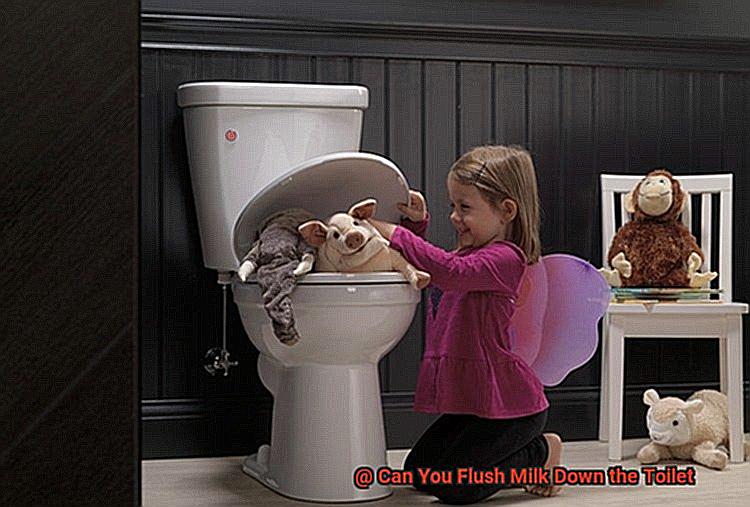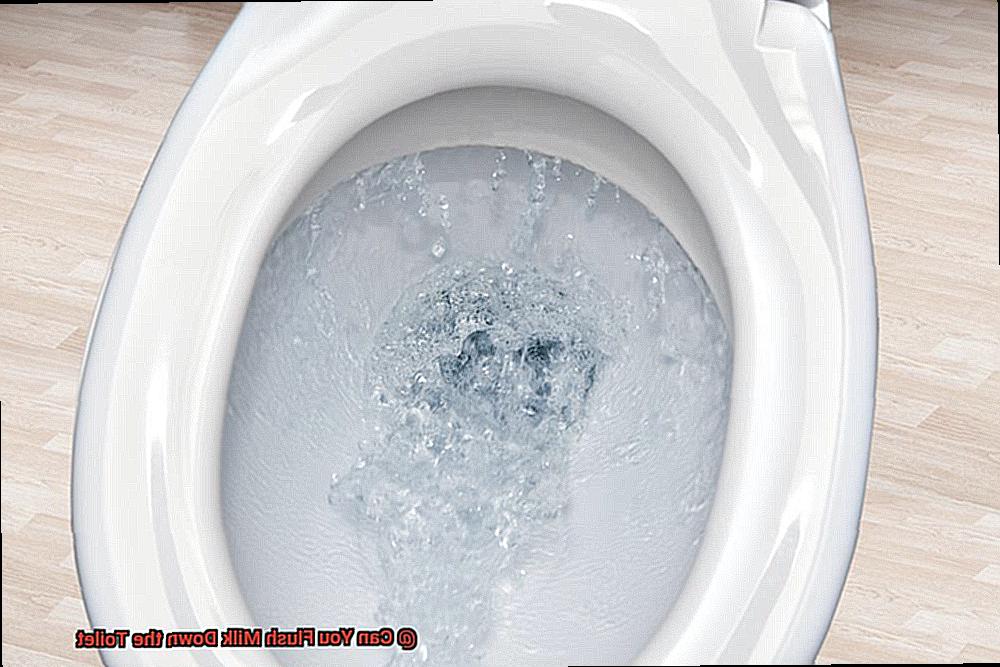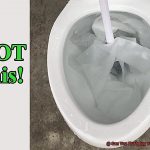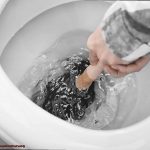Stuck with a carton of expired milk and no clue what to do? Don’t worry, you’re not alone. Pouring the liquid down the drain or into the garbage might be your go-to solution, but have you ever considered flushing it down the toilet? It seems like a quick fix, but can you really flush milk down the toilet without any consequences?
Before you make any decisions, it’s essential to understand the potential problems that could arise from this action. The enzymes and bacteria in milk can create blockages and clogs in your plumbing system, leading to costly repairs or even an overflow of sewage. Flushing milk down the toilet is definitely not something you want to take lightly.
But wait. It’s not as simple as a straightforward ‘yes’ or ‘no.’ Several factors such as the age and volume of milk and your plumbing system’s capacity can impact whether or not it’s safe to flush milk.
In this post, we’ll dive deep into the science behind flushing milk and explore its environmental impact. We’ll also provide practical advice on how to dispose of milk safely and responsibly. So grab a cuppa joe (or tea) and join us on this journey into the world of milk disposal.
Contents
What is Milk and Why Shouldn’t You Flush It?
Milk, a beloved dairy product consumed all over the world, is more than just a tasty treat. It’s a nutritious liquid produced by mammals like cows, goats, and sheep to nourish their young. Packed with essential nutrients such as calcium, protein, and vitamins like B12 and D, milk is an important part of a healthy diet. However, when it comes to disposing of leftover milk, flushing it down the toilet is a definite no-no.

Why? Well, for starters, milk can actually cause serious damage to your plumbing system and the environment. When flushed down the toilet, milk can combine with other waste products to form clumps that clog pipes and create blockages. These blockages can lead to costly repairs and even sewage backups in your home. Not to mention that wastewater treatment plants are not equipped to handle large amounts of fat and protein from milk. This can cause excess foam and foul odors, which can be harmful to the environment.
But that’s not all. Flushing milk down the toilet can have negative impacts on our environment too. Milk contains nutrients that can promote the growth of algae and other aquatic plants when they’re released into bodies of water. This overgrowth of plants depletes oxygen levels in the water and harms aquatic life.
So now that we know why we shouldn’t flush milk down the toilet, what should we do instead? Simply dispose of leftover milk properly by pouring it down the drain or into a container for recycling or composting.
This small action can make a big impact on preventing plumbing problems and protecting our environment from harmful substances.
Plumbing Issues Caused by Flushing Milk
You may want to reconsider this practice as it can cause significant plumbing issues that can lead to costly repairs and even harm the environment.
Milk is a thick, viscous liquid that is notorious for clogging pipes. When flushed down the toilet, it can create blockages in the plumbing system, leading to backups and sewage spills. These blockages can happen in both residential and commercial plumbing systems, causing significant damage and resulting in expensive repairs.
One of the most significant problems caused by flushing milk down the toilet is the formation of fatbergs. Fatbergs are solid masses made up of congealed fat, oil, grease, and other non-biodegradable materials that accumulate in sewer systems. They cause blockages that can lead to sewage backups, contamination of water sources, and property damage. The fat present in milk is one of the primary contributors to fatberg formation, making it a significant culprit when it comes to plumbing issues.
Moreover, flushing milk down the toilet can also lead to the growth of harmful bacteria and mold. Being an organic substance, milk provides an ideal breeding ground for bacteria and mold growth. When flushed down the toilet, it creates an environment that allows these microorganisms to thrive, contaminating water sources and posing health risks.
Finally, flushing milk down the toilet can also spell trouble for septic systems. Septic systems rely on bacteria to break down waste materials. When milk is introduced into the septic system, it disrupts the bacterial balance and causes malfunctions. This can lead to pricey repairs and even hazardous conditions for people and animals living near the septic system.
To avoid costly plumbing issues and safeguard your home or business from potential damage, it’s essential to dispose of milk properly by pouring it into a sink or trash can instead of flushing it down the toilet. Taking simple steps to dispose of milk correctly can go a long way in preventing plumbing issues and protecting water sources.
Environmental Impact of Flushing Milk
When milk is flushed, it makes its way to the sewage treatment plant where it mixes with other waste products. However, the high organic content of milk causes an increase in the biological oxygen demand (BOD) of the wastewater. This means that the bacteria in the treatment plant require more oxygen to break down the waste, which leads to a decrease in dissolved oxygen levels in the water. This decrease can be detrimental to aquatic life, as many fish and other organisms rely on oxygen to survive.
Moreover, flushing milk down the toilet can also contribute to an increase in greenhouse gas emissions. When organic materials like milk decompose in landfills or wastewater treatment plants, they release methane gas, which is a potent greenhouse gas that contributes to climate change.
The consequences don’t stop there. The high organic content of milk can also lead to the growth of harmful bacteria and pathogens in the wastewater treatment plant. These harmful organisms can then be released into the environment, potentially causing harm to both human health and wildlife.
It’s clear that flushing milk down the toilet is not a sustainable or responsible way to dispose of it. Instead, we should pour milk down the drain or put it in compost where it can be properly broken down without harming our environment. By taking these small steps, we can all play a part in protecting our planet and preserving its natural resources for future generations.
Legal Implications of Flushing Milk
Although it may seem like a quick and easy solution, it can have severe consequences.
Did you know that in many areas, it is illegal to dump anything other than human waste and toilet paper down the toilet? Flushing non-biodegradable items, such as milk, can cause blockages in the sewer system and harm the environment. As a result, individuals who violate this law may face fines or penalties. For instance, in the UK, violators of the Water Industry Act of 1991 can face fines of up to £5,000.
Moreover, flushing milk down the toilet can be a costly mistake for homeowners and businesses. Milk is a liquid that can easily spoil and create unpleasant odors in plumbing systems. This can lead to expensive repairs and maintenance bills.
It is essential for individuals to dispose of milk properly by pouring it into a sink or drain with running water or by placing it in a sealed container and throwing it in the trash. By doing so, individuals can avoid legal and financial consequences while also protecting the environment.
Alternatives to Flushing Milk
Not only can it cause plumbing problems, but it also harms the environment. Luckily, there are several alternative methods for disposing of milk that are both easy and eco-friendly.
One of the simplest solutions is to pour the milk into a container with a lid and toss it in the trash. It doesn’t require any special equipment and is a safe way to dispose of milk. Just make sure to seal the container tightly to prevent leaks or spills.
Composting is another excellent option for disposing of milk. You can mix milk with other organic materials like food scraps and yard waste in your compost pile. However, be sure to use small quantities and mix it thoroughly with other materials to avoid bad odors or attracting pests.
If you have pets, consider giving them the milk as a treat. Many dogs and cats love milk, and it can provide them with additional nutrients. However, check if your pet has lactose intolerance before giving them milk.
Lastly, you can use milk as a fertilizer for your plants or garden as it contains valuable nutrients like calcium and nitrogen that help plant growth. Dilute the milk with water and use it to water your plants.
0qOljXNeVnc” >
Conclusion
To sum it up, flushing milk down the toilet is a big no-no. It can wreak havoc on your plumbing system and harm the environment in more ways than one. The organic matter present in milk can cause blockages and clog pipes, leading to costly repairs or even sewage backups in your home or business. Moreover, wastewater treatment plants are not equipped to handle large amounts of fat and protein from milk, which can create excess foam and unpleasant odors that pollute our environment.
The good news is that disposing of leftover milk safely is easy-peasy. You can either pour it down the drain with running water or put it in a sealed container for recycling or composting. However, keep in mind that dumping anything other than human waste and toilet paper down the toilet is illegal in many areas, and violators may face fines or penalties.
Thankfully, there are plenty of alternative methods for getting rid of milk without harming the environment or breaking any laws. You can use it as a treat for your pets, fertilize your plants with it, compost it, or simply toss it in a sealed container in the trash.






